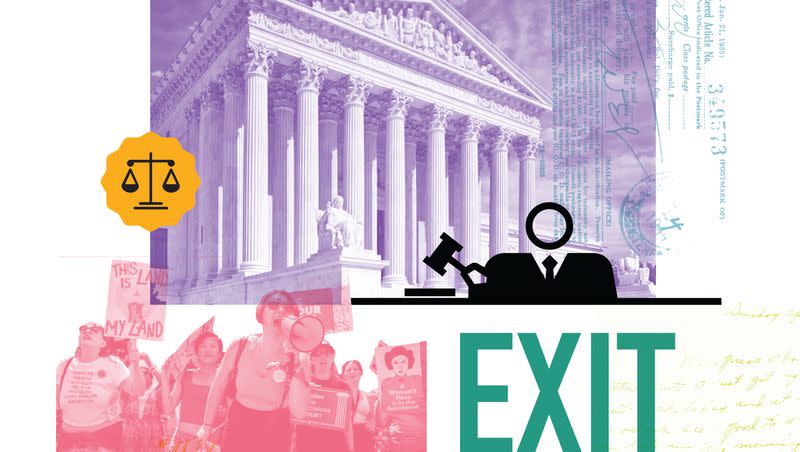Measured justice

The Supreme Court is having a rough go. In theory, justices on the nation’s highest tribunal are shielded from the political fray, so they can interpret the law without regard to the currents of a given moment. But today they find themselves at the center of Beltway maneuvers and troubled times, from politically charged confirmation hearings to the premature leak of its decision on abortion and ethical questions about unreported gifts.
The court’s approval rating has hit an all-time low of just 40%, according to Gallup. Some have called for reform, largely focused on term limits or expanding the court. But does the court need fixing?
Changing with the times
The Supreme Court is a global outlier, with a politicized nomination procedure, lifetime terms and uncommon power. That reach is a problem, argues Jay Willis, editor-in-chief of “Balls & Strikes,” a progressive news site focused on the courts. “It has an insane amount of power relative to the supreme courts of almost every other country,” he told Foreign Policy last year. “It is one of the few high courts that has the unilateral authority to look at a piece of legislation passed by two independent, politically accountable branches of government and be like, ‘Nah, not allowed.’”
Judicial review has been well established since 1803, but some argue that Congress can limit the high court’s jurisdiction. This was explored in the final report from the Presidential Commission on the Supreme Court, issued in 2021, along with moves like court expansion and term limits. But without a constitutional amendment, the court itself could simply strike down any legislative reforms. “If adopted by statute,” writes Rosalind Dixon, law professor at the University of New South Wales in Australia, “it would come before the Supreme Court for review — and the court might well reject the argument.”
While there is historical precedent for court expansion — President Joe Biden opposes the idea — term limits may be the most viable path for reform. In 2021, 17 House Democrats co-sponsored a bill that would establish 18-year terms for Supreme Court justices, who would be appointed every two years. Senior justices could continue to work but would no longer decide cases. The bill would also waive the Senate’s advice and consent authority if the body does not act on a presidential appointment within 120 days.
Reform could have a surprising ally, if Chief Justice John Roberts stands by a memo he sent to the White House in 1983. “Setting a term of, say, 15 years would ensure that federal judges would not lose all touch with reality through decades of ivory tower existence. It would also provide a more regular and greater degree of turnover among the judges. Both developments would, in my view, be healthy ones. Denying reappointment would eliminate any significant threat to judicial independence.”
If it’s not broke, don’t fix it
Perhaps the Supreme Court is doing precisely what it was meant to do. Each justice in the conservative majority was nominated by a Republican president and confirmed by the Senate when each seat became vacant. The third branch of government remains separate but equal. Even the basis for judicial review is found in Article 3 of the Constitution.
While Congress has the power to change the number of justices, it hasn’t done so since 1869, settling at nine following a period of upheaval. The last president who sought to expand the court was Franklin D. Roosevelt, which is largely seen as an effort to secure judicial imprimatur for aggressive economic programs in the New Deal. Congress rejected that legislation, which still resonates as a hand-slap to executive overreach. That may explain Biden’s reluctance to cooperate with the more activist wing of the Democratic party.
Term limits are also not a new idea. But the Founding Fathers chose to grant lifetime seats, in part to protect judges from being swayed by financial need. As Alexander Hamilton wrote in The Federalist Papers, No. 79, “Nothing can contribute more to the independence of the judges than a fixed provision for their support.” Article 3 provides that judges “shall hold their Offices during good Behaviour.” So they can be removed through impeachment, just like a president. That last happened in 1804. In practice, limiting turnover also helps to make the court more consistent over time.
Some fear that term limits would have the opposite of the desired effect. Writing for The Washington Post, Judge J. Harvie Wilkinson III of the 4th U.S. Circuit Court of Appeals contends that term limits would only exacerbate the court’s perceived faults. “They will make the institution appear more, not less, political in the eyes of the public. Confirmation battles will become more numerous but no less feverish, because 18 years is long enough to inflame partisan confirmation passions, especially if the court is closely divided.”
This story appears in the October issue of Deseret Magazine. Learn more about how to subscribe.

